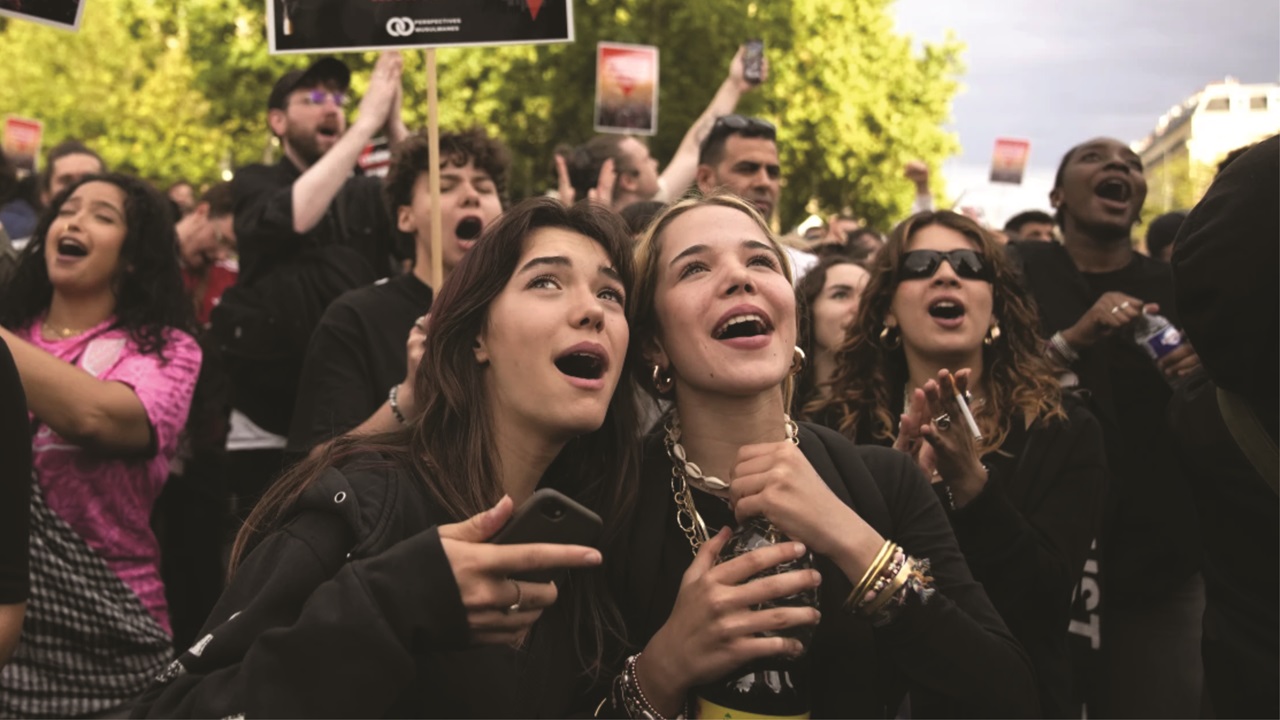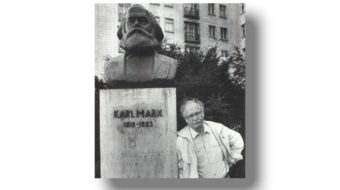
Georgi Dimitrov would be smiling this morning in Marxist heaven, if such a thing existed. The Bulgarian Communist is credited with introducing the “people’s front” (or popular front) strategy of uniting labor, left, progressive, and centrist forces to block fascism back in 1935, and France – the first country to elect a popular front government almost 90 years ago, has just done it again, maybe.
The left-wing “New Popular Front” coalition defied the polls and knocked the neo-fascist National Rally (Rassemblement National) party of Marine Le Pen and Jordan Bardella out of first place in the final round of parliamentary elections.
The left bloc’s victory is a win not just for democracy and the working class in France; it is also proof for those of us fighting similar battles against the extreme right that broad unity, organization, and mass mobilization are the way ahead. With less than four months to go before the U.S. elections and the “Biden question” diverting attention away from the effort needed to block Trump, the popular front strategy is more relevant than ever.
France’s example
The New Popular Front is an alliance of the French Communist Party (PCF), France Insoumise (France Unbowed, the party of Jean-Luc Mélenchon), the center-left Socialist Party (PS), and Les Écologistes (a green environmentalist party).

The coalition won 182 seats in France’s 577-member National Assembly, the most seats but not an outright majority. In second place was President Emmanuel Macron’s center-right Ensemble group, with 163. National Rally captured only 143 seats, despite media predictions it was going to win.
Coming in first should give the New Popular Front the right to form a government and propose a new prime minister. But Macron, with the support of big business, continues to stoke fears of the left, just as he did in the elections. He’s looking for a way to keep New Popular Front out of power and has asked his current prime minister, Gabriel Attal, to stay on “temporarily,” even though the latter offered his resignation.
The president’s maneuvering to block the left and working class-backed parties is no surprise, however. Macron is a former investment banker who worked for Rothschild & Cie Banque before being plucked by former President François Hollande to become finance minister ten years ago.
In that role and later as president, he pursued policies that privatized or deregulated major sections of the French economy, made layoffs easier, raised the retirement age for workers, and pursued other capitalist class priorities.
He faced brutal criticism from all sides throughout the election campaign; most people think he essentially helped the fascists nearly take over the country by calling for the vote in the first place. Even Attal criticized his boss.
Macron plunged the country into the snap election following the National Rally’s runaway win in EU parliamentary elections in early June. He gambled that fear of the right would help him steal voters away from the left and strengthen his control of parliament.
National Rally—formerly known as the National Front—was founded in 1972 by anti-Semite and Holocaust denier Jean-Marie Le Pen to unite the extreme nationalist right. Among its founders were veterans of the French division of Hitler’s Waffen-SS and supporters of the collaborationist Vichy regime of World War II, which helped the Nazis rule France after they invaded the country.
Now led by Jean-Marie Le Pen’s daughter, Marine Le Pen, the party has tried to paper over its fascist roots, but it maintains the same toxic anti-immigrant positions, and members are frequently outed as racists in the press. But like many neo-fascist parties, National Rally has also taken steps to make itself amenable to the neoliberal ideology of the capitalist ruling class, accepting the euro currency and promising to follow the budget demands of the big banks.
The Communist Party (PCF) warned that “the noose is tightening” on democracy in France following the National Rally’s string of advances. To block the descent into far-right rule, it took the lead in initiating the New Popular Front.
Rather than competing and splitting the votes of the left, the parties of the New Popular Front ran a bloc of common candidates in France’s 577 constituencies, dividing the seats among themselves. After the first round on June 30, in any constituency where it looked like National Rally might win, the coalition stuck to its united front tactics and backed whoever had the best chance of beating the right, whether they were a New Popular Front candidate or not.
Macron’s forces cooperated in several districts, but in others, they clung on, even if it meant fracturing the anti-fascist vote and handing the seat to National Rally. If he had ordered his party to cooperate more closely with the left and pro-republican forces, the scale of the National Rally’s defeat might have been even greater.
Trade unions, mass organizations, environmental advocates, and other citizen groups, however, did rally to the New Popular Front’s message of unity. The Confédération Générale du Travail (CGT, France’s largest union federation) gave the bloc its “full support.” The situation was reminiscent of the original Popular Front victory in the 1936 elections, which saw the Communist Party, the Socialist Party, and the CGT all unite to stop fascism.
People’s Front USA
Donald Trump and Marine Le Pen are expressions of the same far-right, racist, corporate-backed trend. In France’s 2017 presidential election, Trump gave her a strong endorsement, calling her the “strongest candidate,” while his now-imprisoned adviser Steve Bannon offered his services to her party.
It took broad unity to block Le Pen and the National Rally this weekend in France. Though the political institutions and voting systems in the U.S. are very different, a similar strategic approach is required to block Trump and the MAGA Republicans here.
The U.S. doesn’t have a multiparty system, a proportional representation electoral arrangement, or a historical memory of what direct fascist rule looks like. That means the tactics and messaging will be different here and the alliances less formal, but it’s worth remembering that the popular front strategy has strong roots in our country, too.
In the 1930s, in the midst of the Great Depression and with World War II looming, communists, labor activists, liberals, Democrats, and other progressives came together to block the road to fascism in America. (Along the way, they also organized unions in the major industries and won Social Security and unemployment insurance.)
In the U.S., the strategy was called “the People’s Front.” Drawing on the experiences witnessed in places like France, the U.S., Germany, Britain, and others, Dimitrov pulled together the lessons learned from both victories and losses in the struggle against fascism to craft the popular front strategy, which he presented at the 7th World Congress of the Communist International in 1935. U.S. Communists helped craft the global left’s turn that Dimitrov put into writing.
The Popular Front: Read the original strategy in Dimitrov’s classic 1935 text, Against Fascism and War, available from International Publishers.
At the core of the popular front strategy is the idea of broad-based coalition politics, and it’s formulated around a couple of key strategic questions. First, it asks what goal, if won, can change the relationship of forces and open up the possibility for advance. Second, it sets out who are the main opponents and possible allies in the struggle to achieve that goal. This means determining who has the self-interest to fight for the goal and assessing their organization, consciousness, and capacity to join in the fight.
For the People’s Front of the 1930s, the goal was the containment of fascism and the defeat of the anti-New Deal section of capital and the Republican Party. As delegates to a convention of the Communist Party heard in June 1936, “There are two chief and opposite directions of possible development in political life…. All parties and groups must be judged by their relation to these two fundamental political tendencies.”
To win a people’s recovery program in the Great Depression, meant lining up all the forces of progress on one side to take on the forces of reaction on the other.
A December 1936 document followed up: “Our country, in common with the rest of the capitalist world, is threatened with reaction, fascism, and war…. Everything that organizes and activates the working class and its allies is progress toward socialism; likewise, everything that weakens and discourages the forces of reaction goes in the same direction.”
There were two main camps, and those who cared about stopping the worst assaults of the reactionary right and opening a way forward had to pick sides. The CPUSA has followed some variation of the People’s Front strategy ever since, making adjustments as circumstances demanded – right up to the present day.
Today, in 2024, we face a challenge similar to that of the 1930s. Whatever may happen within the Democratic Party when it comes to the question of Biden’s candidacy, the task for the labor, left, and people’s movements is still to stop Trump and MAGA fascism. If the latter wins, all bets are off when it comes to the question of whether any democratic space will remain for us to organize, mobilize, and resist going forward.
A major part of building the unity that’s needed, of course, is also fighting for the Biden administration to dump its own reactionary policies, like backing Israel’s genocide in Gaza and its Trump-like immigration policies. The White House’s approach on these issues puts unity in peril.
Black voters and their organizations, by and large, understand the threat facing the country and serve as an example to follow. Surveying the recent string of reactionary Supreme Court rulings, the NAACP, for instance, blasted out the warning: “Elections have consequences. This is what Trump was able to do in the last term, what would the next look like?”
What is to be done next?
For the left and democratic forces in France, they now move on to the next step: figuring out how to govern and implement a pro-working class policy agenda, starting with picking a prime minister. They’ll have to cooperate with Macron and his center forces while also contending with a larger far-right bloc in parliament.
But because they followed a popular front approach, they have preserved and expanded the space for progressive advancement and democratic struggle. The fascists were beaten back for now, and there are real opportunities to make new gains for workers, women, people of color, immigrants, and youth in France.

Here in the U.S., we’ve still got to a lot of work to do in the months ahead. We have to fight to preserve and further build unity among the anti-MAGA majority. We have to resist the media’s temptations to sink into a contest of personalities that the Biden “replacement debate” has sparked. Instead of getting too caught up in the speculation of who might replace the president at the top of the ticket, what we need to fight for right now are replacement policies on issues like Gaza and the border.
And above all, we need to keep highlighting the threat posed by MAGA fascism; the dictatorial desires of Trump and his enablers in the courts, Congress, and right-wing-controlled state legislatures; and the Project 2025 schemes being drafted on behalf of the capitalist class by outfits like the Heritage Foundation.
French workers showed us what can be done: The popular front strategy is still our best hope to block fascism and open the road to new victories.
As with all op-ed and news analytical articles published by People’s World, this article reflects the opinions of its author.
We hope you appreciated this article. At People’s World, we believe news and information should be free and accessible to all, but we need your help. Our journalism is free of corporate influence and paywalls because we are totally reader-supported. Only you, our readers and supporters, make this possible. If you enjoy reading People’s World and the stories we bring you, please support our work by donating or becoming a monthly sustainer today. Thank you!











